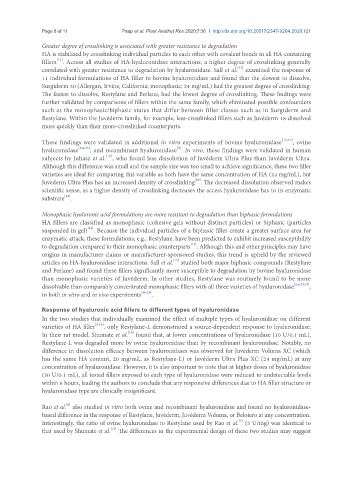Page 396 - Read Online
P. 396
Page 6 of 11 Paap et al. Plast Aesthet Res 2020;7:36 I http://dx.doi.org/10.20517/2347-9264.2020.121
Greater degree of crosslinking is associated with greater resistance to degradation
HA is stabilized by crosslinking individual particles to each other with covalent bonds in all HA-containing
[12]
fillers . Across all studies of HA-hyaluronidase interactions, a higher degree of crosslinking generally
[12]
correlated with greater resistance to degradation by hyaluronidase. Sall et al. examined the response of
11 individual formulations of HA filler to bovine hyaluronidase and found that the slowest to dissolve,
Surgiderm 30 (Allergan, Irvine, California; monophasic; 24 mg/mL) had the greatest degree of crosslinking.
The fastest to dissolve, Restylane and Perlane, had the lowest degree of crosslinking. These findings were
further validated by comparisons of fillers within the same family, which eliminated possible confounders
such as the monophasic/biphasic status that differ between filler classes such as in Surgiderm and
Restylane. Within the Juvéderm family, for example, less-crosslinked fillers such as Juvéderm 18 dissolved
more quickly than their more-crosslinked counterparts.
These findings were validated in additional in vitro experiments of bovine hyaluronidase [14,17] , ovine
[6]
hyaluronidase [2,6,15] , and recombinant hyaluronidase . In vivo, these findings were validated in human
[18]
subjects by Juhasz et al. , who found less dissolution of Juvéderm Ultra Plus than Juvéderm Ultra.
Although this difference was small and the sample size was too small to achieve significance, these two filler
varieties are ideal for comparing this variable as both have the same concentration of HA (24 mg/mL), but
[27]
Juvederm Ultra Plus has an increased density of crosslinking . The decreased dissolution observed makes
scientific sense, as a higher density of crosslinking decreases the access hyaluronidase has to its enzymatic
[12]
substrate .
Monophasic hyaluronic acid formulations are more resistant to degradation than biphasic formulations
HA fillers are classified as monophasic (cohesive gels without distinct particles) or biphasic (particles
[35]
suspended in gel) . Because the individual particles of a biphasic filler create a greater surface area for
enzymatic attack, these formulations, e.g., Restylane, have been predicted to exhibit increased susceptibility
[12]
to degradation compared to their monophasic counterparts . Although this and other principles may have
origins in manufacturer claims or manufacturer-sponsored studies, this trend is upheld by the reviewed
[12]
articles on HA-hyaluronidase interactions. Sall et al. studied both major biphasic compounds (Restylane
and Perlane) and found these fillers significantly more susceptible to degradation by bovine hyaluronidase
than monophasic varieties of Juvéderm. In other studies, Restylane was routinely found to be more
dissolvable than comparably concentrated monophasic fillers with all three varieties of hyaluronidase [2,6,15,17] ,
in both in vitro and in vivo experiments [16,18] .
Response of hyaluronic acid fillers to different types of hyaluronidase
In the two studies that individually examined the effect of multiple types of hyaluronidase on different
varieties of HA filler [6,16] , only Restylane-L demonstrated a source-dependent response to hyaluronidase.
[16]
In their rat model, Shumate et al. found that, at lower concentrations of hyaluronidase (10 U/0.1 mL),
Restylane-L was degraded more by ovine hyaluronidase than by recombinant hyaluronidase. Notably, no
difference in dissolution efficacy between hyaluronidases was observed for Juvéderm Voluma XC (which
has the same HA content, 20 mg/mL, as Restylane-L) or Juvéderm Ultra Plus XC (24 mg/mL) at any
concentration of hyaluronidase. However, it is also important to note that at higher doses of hyaluronidase
(30 U/0.1 mL), all tested fillers exposed to each type of hyaluronidase were reduced to undetectable levels
within 6 hours, leading the authors to conclude that any responsive differences due to HA filler structure or
hyaluronidase type are clinically insignificant.
[6]
Rao et al. also studied in vitro both ovine and recombinant hyaluronidase and found no hyaluronidase-
based difference in the response of Restylane, Juvéderm, Juvéderm Voluma, or Belotero at any concentration.
[6]
Interestingly, the ratio of ovine hyaluronidase to Restylane used by Rao et al. (5 U/mg) was identical to
[16]
that used by Shumate et al. The differences in the experimental design of these two studies may suggest

